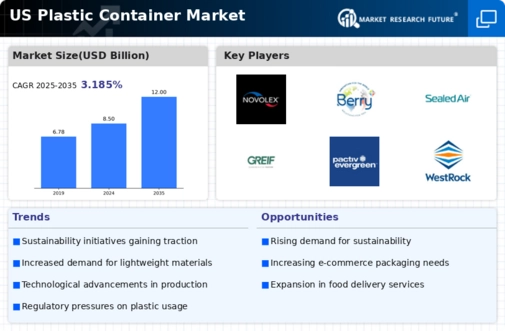Growth of the Retail Sector
The retail sector in the United States is undergoing a transformation, which is positively influencing the plastic container market. With the rise of supermarkets, convenience stores, and specialty retailers, the demand for effective packaging solutions is escalating. Retailers are increasingly seeking packaging that not only preserves product quality but also enhances shelf appeal. This trend is particularly relevant in the food and beverage industry, where visually appealing packaging can significantly influence consumer purchasing decisions. The retail market is projected to grow at a CAGR of around 3.2% through 2025, which is likely to drive demand for innovative plastic containers. As retailers prioritize packaging that meets both functional and aesthetic requirements, the plastic container market is expected to benefit from this evolving landscape.
Emergence of Biodegradable Alternatives
The emergence of biodegradable alternatives is reshaping the plastic container market. As environmental concerns gain prominence, consumers are increasingly seeking sustainable packaging options. This shift is prompting manufacturers to explore biodegradable materials that can reduce the ecological footprint of plastic containers. The market for biodegradable plastics is anticipated to grow at a CAGR of approximately 6% over the next five years, indicating a significant opportunity for innovation within the plastic container market. Companies are investing in research and development to create products that not only meet consumer demands for sustainability but also maintain the functionality and durability expected from traditional plastic containers. This trend towards biodegradable solutions is likely to influence purchasing decisions and drive growth in the plastic container market.
Rising Demand for Convenience Packaging
The plastic container market is experiencing a notable surge in demand for convenience packaging solutions. As consumer lifestyles become increasingly fast-paced, the need for easy-to-use, portable packaging options is paramount. This trend is particularly evident in the food and beverage sector, where ready-to-eat meals and on-the-go snacks are gaining traction. According to recent data, the convenience food segment is projected to grow at a CAGR of approximately 4.5% through 2026, driving the plastic container market forward. Additionally, the rise of single-serve packaging options is influencing manufacturers to innovate and adapt their product lines to meet consumer preferences. This shift towards convenience is likely to bolster the overall growth of the plastic container market, as companies strive to provide solutions that align with modern consumer habits.
Increased Focus on Food Safety Regulations
Food safety regulations are becoming increasingly stringent in the United States, significantly impacting the plastic container market. Regulatory bodies are enforcing stricter guidelines regarding the materials used in food packaging, necessitating that manufacturers comply with safety standards. This heightened focus on food safety is prompting companies to invest in high-quality, compliant materials for their plastic containers. As a result, the market is witnessing a shift towards BPA-free and recyclable options, which are perceived as safer by consumers. The demand for food-safe plastic containers is expected to rise, with the market projected to reach $30 billion by 2027. This regulatory landscape is likely to drive innovation and investment in the plastic container market, as companies seek to enhance their product offerings while adhering to safety standards.
Technological Innovations in Manufacturing
Technological innovations in manufacturing processes are playing a crucial role in shaping the plastic container market. Advances in automation, 3D printing, and material science are enabling manufacturers to produce containers that are not only more efficient but also cost-effective. These innovations are facilitating the development of lightweight, durable, and customizable plastic containers that cater to diverse consumer needs. For instance, the adoption of advanced molding techniques is allowing for the creation of complex designs that enhance functionality. The plastic container market is projected to benefit from these technological advancements, with an expected growth rate of 5% annually through 2028. As manufacturers embrace new technologies, they are likely to improve production efficiency and reduce waste, further contributing to the market's expansion.





















Leave a Comment